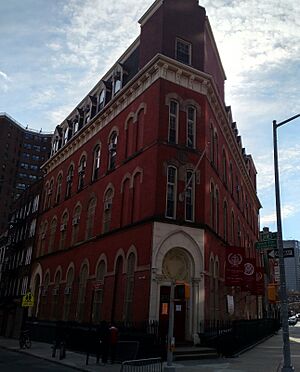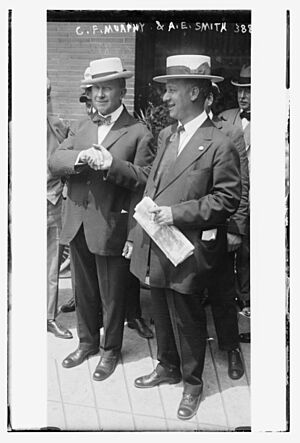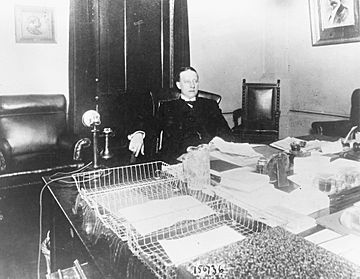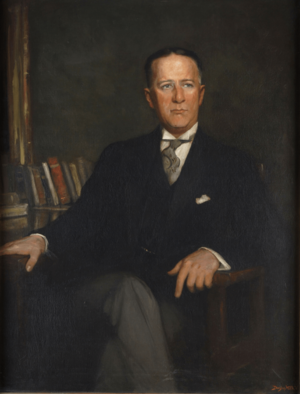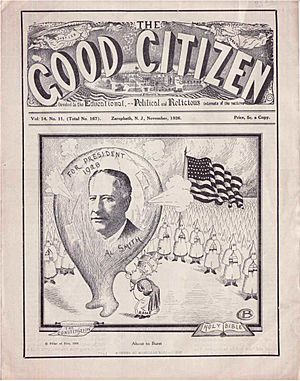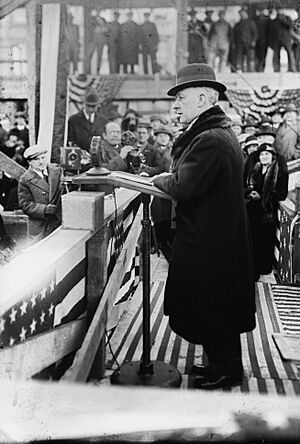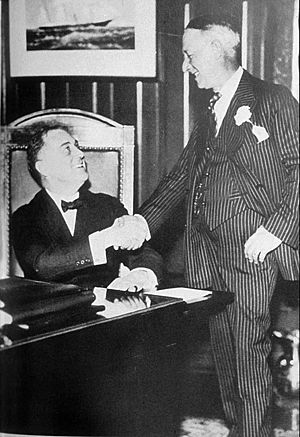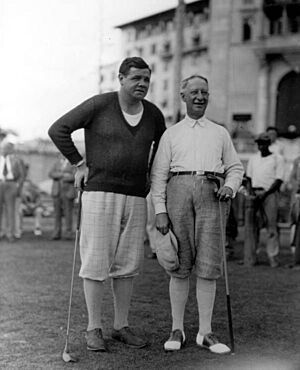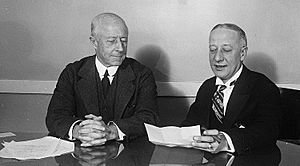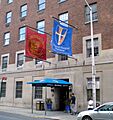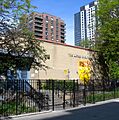Al Smith facts for kids
Quick facts for kids
Al Smith
|
|
|---|---|
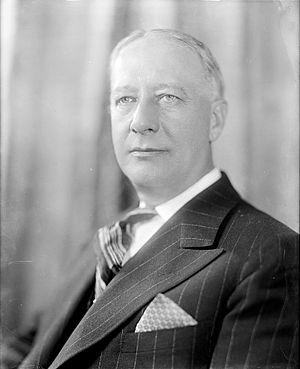
Smith c. 1920s
|
|
| 42nd Governor of New York | |
| In office January 1, 1923 – December 31, 1928 |
|
| Lieutenant | George R. Lunn Seymour Lowman Edwin Corning |
| Preceded by | Nathan L. Miller |
| Succeeded by | Franklin D. Roosevelt |
| In office January 1, 1919 – December 31, 1920 |
|
| Lieutenant | Harry C. Walker |
| Preceded by | Charles S. Whitman |
| Succeeded by | Nathan L. Miller |
| 8th President of the New York City Board of Aldermen | |
| In office January 1, 1917 – December 31, 1918 |
|
| Preceded by | Frank Dowling |
| Succeeded by | Robert L. Moran |
| Sheriff of New York County | |
| In office January 1, 1916 – January 1, 1917 |
|
| Preceded by | Max Samuel Grifenhagen |
| Succeeded by | David H. Knott |
| Member of the New York State Assembly from New York County's 2nd district |
|
| In office January 1, 1904 – December 32, 1915 |
|
| Preceded by | Joseph Bourke |
| Succeeded by | Peter J. Hamill |
| Personal details | |
| Born |
Alfred Emanuel Smith
December 30, 1873 New York City, U.S. |
| Died | October 4, 1944 (aged 70) New York City, U.S. |
| Resting place | Calvary Cemetery |
| Political party | Democratic |
| Spouse |
Catherine Dunn
(m. 1900; died 1944) |
| Children | 5 |
Alfred Emanuel Smith (December 30, 1873 – October 4, 1944) was an American politician. He served four terms as the Governor of New York. He was also the Democratic Party's candidate for president in 1928.
Al Smith grew up on the Lower East Side of Manhattan, New York City. His mother was Irish-American and his father was Civil War veteran and Italian-American. He lived in this neighborhood his whole life.
Smith was connected to Tammany Hall, a powerful political group in New York City at the time. However, he was known for being honest and not involved in corruption. He worked to pass many important laws.
He served in the New York State Assembly from 1904 to 1915. He was also the Speaker of the Assembly in 1913. Smith was elected governor of New York in 1918. He lost his re-election in 1920 but was elected governor again in 1922, 1924, and 1926.
As governor, Smith was known for making government work better and more efficiently. He brought many reforms to New York in the 1920s.
Smith was the first Roman Catholic to be nominated for president by a major political party. His 1928 presidential campaign brought out many voters, both Catholic and non-Catholic. Some people, especially Protestants, worried that the Pope would control his decisions.
Smith was also against Prohibition, which was a law that made alcohol illegal. He had even ended New York's prohibition law as governor. This view attracted voters who disliked the criminal gangs that grew because of Prohibition.
In 1928, Herbert Hoover, a Republican, won the election by a large amount. This was partly because the country was doing well economically. Also, some people had strong feelings against Catholics.
Smith tried to become the Democratic presidential candidate again in 1932. But he lost to Franklin D. Roosevelt, who had been his ally and then became governor after him. After politics, Smith worked in business. He helped build the Empire State Building. He also became a strong critic of Roosevelt's New Deal policies.
Contents
Early Life and Education
Al Smith was born and grew up in the Fourth Ward on the Lower East Side of Manhattan. He lived there his entire life. His mother, Catherine, came from Ireland. His father, Joseph Alfred Smith, had Italian and German family roots. His father fought in the Civil War.
Smith's family faced financial challenges when he was young. He saw the Brooklyn Bridge being built nearby. He later said, "The Brooklyn Bridge and I grew up together." He felt a strong connection to the Irish-American community.
His father, who owned a small trucking business, died when Al was 13. At 14, Smith had to leave St. James parochial school to help his family. He worked at a fish market for seven years. He never went to high school or college. He said he learned about people by watching them at the Fulton Fish Market.
Smith was good at acting in amateur theater. This helped him become well-known and develop his smooth speaking style for politics. On May 6, 1900, Al Smith married Catherine Ann Dunn. They had five children together.
Political Journey
In his political career, Smith often talked about his working-class background. He connected with immigrants and presented himself as a person for the people. He was linked to Tammany Hall, a powerful political group, but he was known for being honest. He worked to pass laws that helped people.
Smith's first political job was in 1895. He worked as an investigator for the Commissioner of Jurors, a job he got through Tammany Hall.
Serving in the State Legislature
Smith was first elected to the New York State Assembly in 1904. He served there until 1915. He became interested in improving conditions for factory workers after meeting Frances Perkins, an activist.
Smith became vice chairman of a state group that looked into factory conditions. This happened after 146 workers died in the Triangle Shirtwaist Factory fire in 1911. Meeting the families of the victims deeply affected him.
With Perkins and Robert F. Wagner, Smith fought against dangerous workplaces. They pushed for new laws to make factories safer. The group visited factories and talked to many witnesses.
Their work led to 38 new laws in New York State. These laws made New York a leader in worker safety. They required better building exits, fire safety, and alarm systems. They also limited how many hours women and children could work.
In 1911, Smith became the Majority Leader in the State Assembly. In 1913, he was elected Speaker. In November 1915, he was elected Sheriff of New York County. By this time, he was a key leader in the Progressive movement in New York.
Governor of New York
After being Sheriff, Smith was elected President of the Board of Aldermen of New York City in 1917. He was then elected Governor of New York in 1918.
Smith lost his re-election in 1920. But he was elected governor again in 1922, 1924, and 1926. In 1922, he openly supported ending Prohibition.
As governor, Smith became known across the country as a progressive leader. He wanted to make government more efficient and better at helping people. His assistant, Robert Moses, helped create the nation's first state park system. New York also improved laws for workers' compensation and women's pensions.
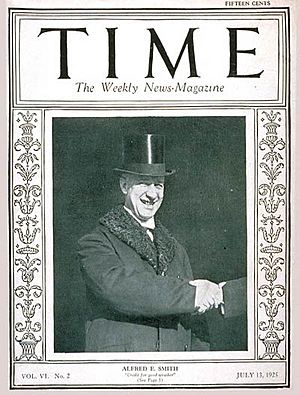
In 1924, Smith tried to become the Democratic candidate for president. Franklin D. Roosevelt gave a famous speech supporting Smith. He called Smith "the Happy Warrior." Smith was against Prohibition, while his main rival, William Gibbs McAdoo, supported it. The party was divided. After many votes, both men stepped aside. The party then chose John W. Davis, who lost the election to Republican Calvin Coolidge.
Smith did not give up. He worked hard to get the party's nomination again in 1928.
The 1928 Presidential Election
Al Smith lost the 1928 election to Herbert Hoover. Many people say he lost because of "Prohibition, Prejudice, and Prosperity." The country was doing well economically, which helped Hoover. Also, there was strong anti-Catholic feeling against Smith.
Smith was Catholic, and this was a big reason for his loss. Many Protestants had fears about Catholicism. They worried that Smith would listen to the Pope instead of the U.S. Constitution. Some newspapers and churches spread these fears. They claimed Catholicism was not compatible with American democracy.
Another issue was Prohibition. Smith wanted to end Prohibition because it led to more crime. The Democratic Party was split on this issue. Smith tried to avoid talking about it during the campaign.
Smith was a good speaker and believed in good government. He won the votes of most Catholics. He also brought many Catholics, especially women, to the polls for the first time. However, he lost support in rural areas and some Southern states.
Smith was not the best campaigner. His campaign song, "The Sidewalks of New York," did not appeal to people in rural areas. His New York accent also sounded unfamiliar on the radio. He narrowly lost New York State. However, Franklin D. Roosevelt was elected to replace him as governor of New York in 1928.
Some experts believe the 1928 election changed how people voted. It helped create the "New Deal coalition" that supported Roosevelt later. This election showed a shift in votes towards urban, working-class, and Catholic voters.
Opposing Roosevelt and the New Deal
Smith felt that Roosevelt had not treated him well during Roosevelt's time as governor. They became rivals in the 1932 Democratic presidential primaries. Smith ran against Roosevelt for the nomination.
After losing the nomination, Smith did campaign for Roosevelt in 1932. He gave an important speech for him.
However, Smith became very critical of Roosevelt's New Deal policies. He felt they went against his ideas of good government and working with businesses. Smith joined the American Liberty League. This group was made up of Democrats who did not like the New Deal. They argued that the New Deal was taking away people's freedom.
The League did not gain much support and closed in 1940. Smith's dislike for Roosevelt's policies was so strong that he supported Republican presidential candidates in the 1936 and 1940 elections.
Even though Smith and Roosevelt had a disagreement, Smith and Eleanor Roosevelt remained friends. Smith and Franklin Roosevelt finally made up shortly before Smith's death.
Life After Politics
After the 1928 election, Al Smith became the president of Empire State, Inc. This company built and managed the Empire State Building. Construction started on March 17, 1930, which is St. Patrick's Day, as Smith wanted.
The Empire State Building opened on May 1, 1931. It was built in only 13 months, which was a record for such a large project. Smith continued to promote the building, even when it was called the "Empty State Building" because it had few tenants.
In 1929, Smith received the Laetare Medal from the University of Notre Dame. This is a very important award for American Catholics.
Smith was an early and strong critic of the Nazi government in Germany. He supported a boycott against Nazi Germany in 1933. He spoke out against Nazism at a large meeting in Madison Square Garden.
In 1938, Smith spoke on the radio to condemn Nazi violence after Kristallnacht. Like many New York City businessmen, Smith strongly supported the United States joining World War II. He pushed for policies that would allow the U.S. to sell war equipment to the British.
In 1939, Smith received a high honor from the Pope, becoming a Papal Chamberlain of the Sword and Cape.
Al Smith died on October 4, 1944, at age 70, from a heart attack. He had been very sad after his wife died five months earlier. He is buried at Calvary Cemetery.
Legacy and Memorials
Many buildings and places are named after Al Smith. These include:
- The Alfred E. Smith Building, a skyscraper in Albany, New York.
- Governor Alfred E. Smith Houses, a public housing area in Lower Manhattan.
- Governor Alfred E. Smith Park, a playground in Manhattan.
- Governor Alfred E. Smith, a fireboat in the New York City Fire Department.
- Governor Alfred E. Smith Sunken Meadow State Park, a state park in Smithtown.
- Alfred E. Smith Recreation Center, a youth center in Manhattan.
- PS 163 Alfred E. Smith School and PS 1 Alfred E. Smith School, two schools in Manhattan.
- Alfred E. Smith Career and Technical Education High School in the South Bronx.
- Alfred E. Smith Memorial Foundation Dinner, a fundraiser for Catholic Charities.
- Smith Hall, a residence hall at Binghamton University and Farmingdale State College.
- Camp Smith, a military base in Cortlandt Manor, New York.
Images for kids
Electoral History
New York Gubernatorial Elections
| Governor candidate | Running Mate | Party | Popular Vote | |
|---|---|---|---|---|
| Alfred E. Smith | Harry C. Walker | Democratic | 1,009,936 | (47.37%) |
| Charles S. Whitman | Edward Schoeneck (Republican), Mamie W. Colvin (Prohibition) |
Republican, Prohibition |
995,094 | (46.68%) |
| Charles Wesley Ervin | Ella Reeve Bloor | Socialist | 121,705 | (5.71%) |
| Olive M. Johnson | August Gillhaus | Socialist Labor | 5,183 | (0.24%) |
| Governor candidate | Running Mate | Party | Popular Vote | |
|---|---|---|---|---|
| Nathan L. Miller | Jeremiah Wood | Republican | 1,335,878 | (46.58%) |
| Alfred E. Smith | George R. Fitts | Democratic | 1,261,812 | (44.00%) |
| Joseph D. Cannon | Jessie Wallace Hughan | Socialist | 159,804 | (5.57%) |
| Dudley Field Malone | Farmer-Labor | 69,908 | (2.44%) | |
| George F. Thompson | Edward G. Deltrich | Prohibition | 35,509 | (1.24%) |
| John P. Quinn | Socialist Labor | 5,015 | (0.17%) | |
- List of candidates, (.pdf) in The New York Times of September 13, 1920
| Governor candidate | Running Mate | Party | Popular Vote | |
|---|---|---|---|---|
| Alfred E. Smith | George R. Lunn | Democratic | 1,397,670 | (55.21%) |
| Nathan L. Miller | William J. Donovan | Republican | 1,011,725 | (39.97%) |
| Edward F. Cassidy | Theresa B. Wiley | Socialist, Farmer-Labor |
109,119 | (4.31%) |
| George K. Hinds | William C. Ramsdell | Prohibition | 9,499 | (0.38%) |
| Jeremiah D. Crowley | John E. DeLee | Socialist Labor | 9,499 | (0.38%) |
| Governor candidate | Running Mate | Party | Popular Vote | |
|---|---|---|---|---|
| Alfred E. Smith | George R. Lunn | Democratic | 1,627,111 | (49.96%) |
| Theodore Roosevelt, Jr. | Seymour Lowman | Republican | 1,518,552 | (46.63%) |
| Norman Mattoon Thomas | Charles Solomon | Socialist | 99,854 | (3.07%) |
| James P. Cannon | Franklin P. Brill | Workers | 6,395 | (0.20%) |
| Frank E. Passonno | Milton Weinberger | Socialist Labor | 4,931 | (0.15%) |
| Governor candidate | Running Mate | Party | Popular Vote | |
|---|---|---|---|---|
| Alfred E. Smith | Edwin Corning | Democratic | 1,523,813 | (52.13%) |
| Ogden L. Mills | Seymour Lowman | Republican | 1,276,137 | (43.80%) |
| Jacob Panken | August Claessens | Socialist | 83,481 | (2.87%) |
| Charles E. Manierre | Ella McCarthy | Prohibition | 21,285 | (0.73%) |
| Benjamin Gitlow | Franklin P. Brill | Workers | 5,507 | (0.19%) |
| Jeremiah D. Crowley | John E. DeLee | Socialist Labor | 3,553 | (0.12%) |
United States Presidential Election, 1928
| Presidential candidate | Party | Home state | Popular vote | Electoral vote |
Running mate | |||
|---|---|---|---|---|---|---|---|---|
| Count | Percentage | Vice-presidential candidate | Home state | Electoral vote | ||||
| Herbert Hoover | Republican | California | 21,427,123 | 58.2% | 444 | Charles Curtis | Kansas | 444 |
| Alfred E. Smith | Democratic | New York | 15,015,464 | 40.8% | 87 | Joseph Taylor Robinson | Arkansas | 87 |
| Norman Thomas | Socialist | New York | 267,478 | 0.7% | 0 | James H. Maurer | Pennsylvania | 0 |
| William Z. Foster | Communist | Illinois | 48,551 | 0.1% | 0 | Benjamin Gitlow | New York | 0 |
| Other | 48,396 | 0.1% | — | Other | — | |||
| Total | 36,807,012 | 100% | 531 | 531 | ||||
| Needed to win | 266 | 266 | ||||||
- Source (Popular Vote):
- Source (Electoral Vote):
Works by Al Smith
- Campaign Addresses of Governor Alfred E. Smith, Democratic Candidate for President 1928. Washington, DC: Democratic National Committee, 1929.
- Progressive Democracy: Addresses & State Papers. 1928.
- Up to Now: An Autobiography (The Viking Press, 1929)
See Also
 In Spanish: Al Smith para niños
In Spanish: Al Smith para niños
- Alfred E. Smith IV, Smith's great-grandson
- List of covers of Time magazine (1920s)
- Al Smith presidential campaign, 1928
- Al Smith presidential campaign, 1932
- J. Raymond Jones


